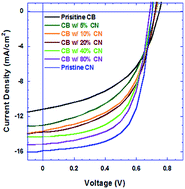Efficient polymer solar cells fabricated from solvent processing additive solution
Abstract
In this study, we investigate the device performance of bulk heterojunction (BHJ) polymer solar cells (PSCs) fabricated from pristine chlorobenzene (CB) solution, CB solutions with different concentrations of solvent processing additive, chloronaphthalene (CN) which has a high boiling point temperature, and pristine CN solution. An efficiency of 7.12% is observed from PSCs processed from pristine CN solution as compared with 4.01% of that from pristine CB solution. The correlation between the efficiency of PSCs with the concentrations of CN was systematically studied by absorption spectra, atomic force microscopy and cross-section transmission electron microscopy images, wide angle X-ray diffraction and grazing incidence small angle X-ray patterns of BHJ active layers and impedance spectroscopies of BHJ PSCs. It was found that the addition of CN into CB solution does not affect the crystallization or the molecular packing of the donor polymer in BHJ layers, but it changes the film morphology of the BHJ layers. The phase separation between the donor polymer and fullerene derivatives was reduced and BHJ layers were redistributed as the concentration of CN is increased in CB solutions. As a result, increased ratios of the donor polymer to fullerene derivatives, and high hole mobilities of the donor polymer in BHJ layers were obtained for the resultant films. Consequently, a high efficiency was observed from PSCs processed from CN solution rather than from CB solution. Our findings provide a method to approach highly efficient PSCs.

- This article is part of the themed collection: 2015 Journal of Materials Chemistry C Hot Papers

 Please wait while we load your content...
Please wait while we load your content...